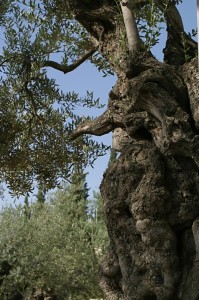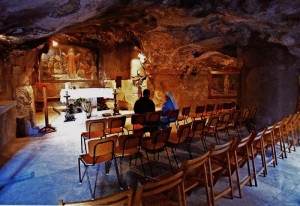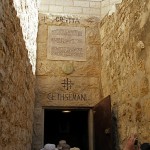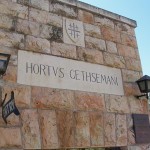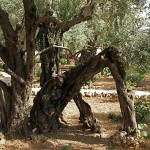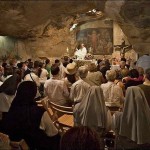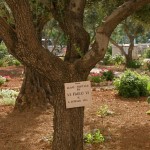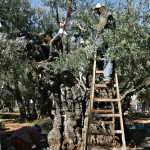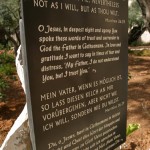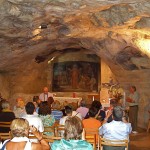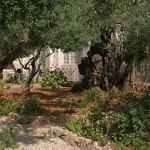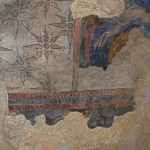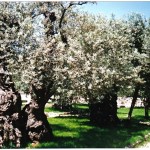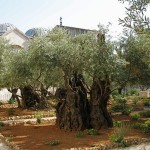Jerusalem

Facade of Church of All Nations (Seetheholyland.net)
The Church of All Nations, standing near the foot of the Mount of Olives in Jerusalem, is built over the rock on which Jesus is believed to have prayed in agony the night before he was crucified.
The church and the adjacent Garden of Gethsemane, with its eight ancient olive trees, provide an evocative place for meditation, especially when visited at night.
The church is also known as the Basilica of the Agony. Completed in 1924, it is the third church on the site.
Its design blends the façade of a typically Roman basilica with a roof of 12 small domes that suggest an Eastern character. The richly-coloured triangular mosaic at the top of the façade makes it a Jerusalem landmark.
Jesus prayed in anguish

Rock of Agony in the Church of All Nations (Seetheholyland.net)
The Gospels of Matthew, Mark and Luke tell that Jesus and his disciples went to the Mount of Olives after the Last Supper.
He left eight of the disciples together in one place and withdrew further with Peter, James and John. He asked them — the three who had witnessed his Transfiguration — to stay awake with him while he prayed.
Jesus “threw himself on the ground” (Matthew 26:39) and in his anguish “his sweat became like great drops of blood falling down on the ground” (Luke 22:44). But the three disciples, all of them fishermen who were used to working through the night, could not stay awake “because of grief” (Luke 22:45).
Then a group from the chief priests and elders arrived to arrest Jesus. They were led by Judas, who betrayed his Master with a kiss.
Sombre atmosphere in church

Main altar in Church of All Nations (Seetheholyland.net)
An atmosphere of sorrowful reverence pervades the Church of All Nations. The architect, Antonio Barluzzi, evoked the night-time of the Agony by leaving the interior in semi-darkness, relieved only by subdued natural light filtered through violet-blue alabaster windows.
The sombre blue of a star-studded night sky is recreated in the ceiling domes, the stars being surrounded by olive branches reminiscent of the Gethsemane garden.
In front of the high altar is a flat outcrop of rock, which a long Christian tradition identifies as the Rock of Agony where Jesus prayed.
There is a large mosaic in each of the three apses. From left to right, they represent The Kiss of Judas, Christ in Agony being Consoled by an Angel, and The Arrest of Jesus.
Many nations contributed
The basilica is called the Church of All Nations because many countries contributed to the cost of construction.
National symbols of 12 donors — Argentina, Belgium, Brazil, Canada, Chile, England, France, Germany, Italy, Mexico, Spain and the United States of America — are inside the ceiling domes.
The mosaics in the apses were donated by Hungary, Ireland and Poland. The wrought-iron wreath around the Rock of Agony was given by Australia.
The wreath is in the form of a crown of thorns with olive branches. A pair of thorn birds in front of a Communion chalice symbolise souls who wish to share the cup of Christ’s Passion. Two silver doves are depicted as sacrificial victims caught in agony in the thorns.

Original mosaic floor discovered
During construction, parts of the mosaic floor of the original Byzantine church were discovered. These were preserved under glass and may be seen in the floor of the south aisle.
The architect then decided to copy this 4th-century mosaic design in the floor of the modern church, to suggest a spiritual continuity throughout the ages of faith.

Triangular mosaic on facade of Church of All Nations (Seetheholyland.net)
On the façade of the Church of All Nations, the triangular area over the great portal displays a much-photographed mosaic.
Christ is depicted as the mediator between God and mankind, on whose behalf he gives his very heart which an angel is shown receiving into his hands.
On Christ’s left, a throng of lowly people, in tears, look to him with confidence. On his right, a group of the powerful and wise acknowledge the shortcomings of their might and learning.
On the summit of the façade stand two stags on either side of a cross. Below the mosaic, statues of the four Evangelists are separated by three arches.
Related site:
Gethsemane
In Scripture:
Jesus prays in Gethsemane: Matthew 26:36-46; Mark 14:32-42; Luke 22:39-46; Mark 32-42
Jesus is arrested: Matthew 26:47-56; Mark 14:43-50; Luke 22:47-53; John 18:1-12
Administered by: Franciscan Custody of the Holy Land
Tel.: 972-2-6266444
Open: 8am-noon, 2-6pm (5pm Oct-Mar)
-

-
Facade of Church of All Nations (Seetheholyland.net)
-

-
Triangular mosaic on facade of Church of All Nations (Seetheholyland.net)
-
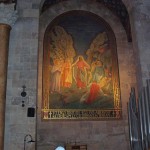
-
“I am he” mosaic of Jesus before his arrest (Seetheholyland.net)
-
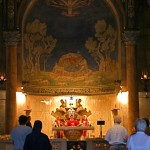
-
Main altar in Church of All Nations (Seetheholyland.net)
-
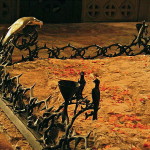
-
Corner of Rock of Agony in Church of All Nations (© Custodia Terrae Sanctae)
-

-
Rock of Agony in the Church of All Nations (Seetheholyland.net)
-

-
Franciscan Monastery at Church of All Nations (© Israel Ministry of Tourism)
-

-
Interior of Church of All Nations (Chris Yunker)
-

-
Christ in agony mosaic in Church of All Nations (Seetheholyland.net)
-
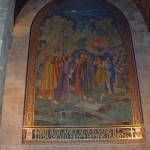
-
Kiss of Judas mosaic in Church of All Nations (Seetheholyland.net)
-

-
Church of All Nations on the Mount of Olives (© Israel Ministry of Tourism)
-

-
Ceiling of Church of All Nations (Caleb Zahnd)
References
Bar-Am, Aviva: Beyond the Walls: Churches of Jerusalem (Ahva Press, 1998)
Gonen, Rivka: Biblical Holy Places: An illustrated guide (Collier Macmillan, 1987)
Maier, Paul L. (trans.): Josephus: The Essential Writings (Kregel Publications, 1988)
Murphy-O’Connor, Jerome: The Holy Land: An Oxford Archaeological Guide from Earliest Times to 1700 (Oxford University Press, 2005)
Dillon, Edward: “The Sanctuaries at Gethsemane”, Holy Land, spring 1998
Storme, Albert: Gethsemane (Franciscan Printing Press, 1970)
Wareham, Norman, and Gill, Jill: Every Pilgrim’s Guide to the Holy Land (Canterbury Press, 1996)
External links
Gethsemane (Custodia Terrae Sanctae)





















